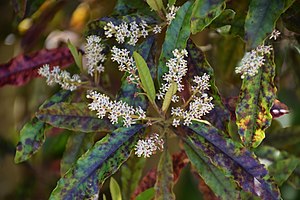Paracryphiaceae
| Paracryphiaceae | ||||||||||||
|---|---|---|---|---|---|---|---|---|---|---|---|---|

Quintinia serrata |
||||||||||||
| Systematics | ||||||||||||
|
||||||||||||
| Scientific name of the order | ||||||||||||
| Paracryphiales | ||||||||||||
| Takht. ex Reveal | ||||||||||||
| Scientific name of the family | ||||||||||||
| Paracryphiaceae | ||||||||||||
| Airy Shaw |
The paracryphiaceae are the only plant family of the order of Paracryphiales within the flowering plant . The family includes only three genera with about 36 species .
description
They grow as trees or bushes . The stalked leaves are simple. Stipules are missing.
The flowers are in spike-like or racemose inflorescences . The flowers are four or five-fold. All stamens are free and fertile . There are one to six upper or lower carpels . The fruit leaves are above or below a constant ovary grown.
Different fruits are formed depending on the genus. More precise features are explained for the individual genera.
Systematics and distribution
The order of the Paracryphiales is within the Euasteriden II the sister group of the order Dipsacales . Only one family belongs to it, the Paracryphiaceae, into which the former families Quintiniaceae and Sphenostemonaceae were also incorporated.
The Paracryphiaceae family was established by Herbert Kenneth Airy Shaw in Kew Bulletin , 18, p. 265 in 1964 . Type genus is Paracryphia Baker f.
The position of the Paracryphiaceae family has long been controversial and is still evaluated differently by different authors today. The Paracryphiaceae was placed in the order Theales as a monotypic family with the only species Paracryphia alticola . The monogeneric family Sphenostomonaceae, with the genus Sphenostemon , was added to the Celastrales or Icacinales. The genus Quintinia has long been assigned to the woody Saxifragaceae or Hydrangeaceae . Most recently, Winkworth et al. 2008 represents three genera in the Paracryphiaceae family. Quintiniaceae Doweld , Sphenostemonaceae P. van Royen are now synonyms of Paracryphiaceae Airy Shaw . For the family Paracryphiaceae a separate order Paracryphiales is established, which is close to the order of the Dipsacales .

The Paracryphiaceae family comprises three genera with about 36 species in the Philippines , New Guinea , New Zealand and New Caledonia .:
-
Paracryphia Baker f. : With the only kind:
- Paracryphia alticola (Schltr.) Steenis : Home is New Caledonia . It grows as a tree. The more or less whorled, stalked leaves are leathery and simple. The leaf margin is finely serrated. Stipules are missing. This species is Andromonöz, so there are plants with male + hermaphrodite flowers. The flowers stand together in paniculate partial inflorescences in annual total inflorescences . The sessile flowers are fourfold. There are two circles with identical, heart-shaped bracts . There are eight (up to rarely eleven) free stamens. Eight to fifteen carpels are fused to form an upper ovary. There are scars in the same number as carpels. There are pomes formed with winged seeds.
- Quintinia A.DC. : With about 25 species of evergreen trees and shrubs in the Philippines , from New Guinea to New Zealand and New Caledonia. (for more information see generic article)
- Sphenostemon Baillon : With about ten species of evergreen trees and shrubs in New Guinea, Australia ( Queensland ) and New Caledonia. The leathery leaves are simple. The flowers stand together in terminal, racemose inflorescences. The hermaphrodite flowers are fourfold. Sepals are always present; Petals may be missing. There are four to twelve free, fertile stamens. Two carpels have grown together to form an upper ovary. The stylus ends in a cephalic scar. There are drupes formed.
swell
- Paracryphiaceae on the AP website - Angiosperm Phylogeny website.
- Paracryphiaceae only with the genus Paracryphia and Sphenostemonaceae only with the genus Sphenostemon in DELTA by L. Watson & MJ Dallwitz.
Individual evidence
- ↑ a b c Paracryphiaceae on the AP website - Angiosperm Phylogeny website.
- ↑ Angiosperm Phylogeny Group : An update of the Angiosperm Phylogeny Group classification for the orders and families of flowering plants: APG III. In: Botanical Journal of the Linnean Society. Vol. 161, No. 2, 2009, ISSN 0024-4074 , pp. 105-121, doi : 10.1111 / j.1095-8339.2009.00996.x .
- ^ Richard C. Winkworth, Johannes Lundberg, Michael J. Donoghue: Toward a resolution of Campanulid phylogeny, with special reference to the placement of Dipsacales. In: Taxon. Vol. 57, No. 1, ISSN 0040-0262 , 2008, pp. 53-65, (PDF; 568 kB) .
- ↑ Paracryphiaceae at DELTA by L. Watson & MJ Dallwitz.
- ↑ Sphenostemonaceae only with the genus Sphenostemon in DELTA by L. Watson & MJ Dallwitz
further reading
- Johannes Lundberg: Phylogenetic Studies in the Euasterids II. With Particular Reference to Asterales and Escalloniaceae (= Comprehensive Summaries of Uppsala Dissertations from the Faculty of Science and Technology. Vol. 676). Uppsala University, Biology, Department of Evolutionary Biology, Department of Systematic Botany, Uppsala 2001, ISBN 91-554-5191-8 (also: Uppsala, Universität, Dissertation, 2002), online (PDF; 0.9 MB) .
- Richard C. Winkworth, Johannes Lundberg, Michael J. Donoghue: Toward a resolution of Campanulid phylogeny, with special reference to the placement of Dipsacales. In: Taxon. Vol. 57, No. 1, ISSN 0040-0262 , 2008, pp. 53-65.